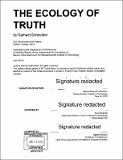The ecology of truth
Author(s)
Schneider, Samuel (Samuel Raphael)
DownloadFull printable version (15.35Mb)
Other Contributors
Massachusetts Institute of Technology. Department of Architecture.
Advisor
Azra Akšamija.
Terms of use
Metadata
Show full item recordAbstract
The spaces we inhabit influence the way we experience our surroundings, but this causal relationship is much weaker than designers and architects like to imagine. The Ecology of Truth investigates these weak effects as a mesoscope; a device designed to interrogate the spaces and relationships between the microscopic-the lab, and the macroscopic-the Institute. The work draws on the aesthetic of the laboratory at MIT-both transparent and reflective-visible, yet inaccessible. In addition to its aforementioned aesthetic influences, The Ecology of Truth derives its esthetic influence from the solipsistic world of architectural language, blending it with scopic histories that run throughout the development of modern science. If the project has a single inspiration it is the Wunderkammer-also known as cabinet of curiosities-the idea that a unified curation of its contained objects re-assembles their spatial lives, turning 'real' objects into a mythic, often singular narratives of the world-a miniature ecological prism, with various competing truths. The life of the work is dynamic-moving around the institute, it captures scientific curios bound for the trash, repurposing them as a narrative gallery of failed objets-types-modern tools transformed into contingent objects of contemporary space. While on the move, the cabinet turns eyes, and hopefully some of the minds behind those puzzled and curious glances. If not, the artist hopes the viewers enjoyed seeing a reflective box, punctuated by apertures, filled with shiny things! Who doesn't like shiny things?
Description
Thesis: M. Arch., Massachusetts Institute of Technology, Department of Architecture, 2018. Cataloged from PDF version of thesis. Page 82 blank. Includes bibliographical references (pages 80-81).
Date issued
2018Department
Massachusetts Institute of Technology. Department of ArchitecturePublisher
Massachusetts Institute of Technology
Keywords
Architecture.